Epic Guide to Grand Canyon National Park in Arizona including both the North and South Rim! Things to do, lodging, camping, history, guided tours, entrance fees, and all the information you need to plan an epic Grand Canyon Vacation.
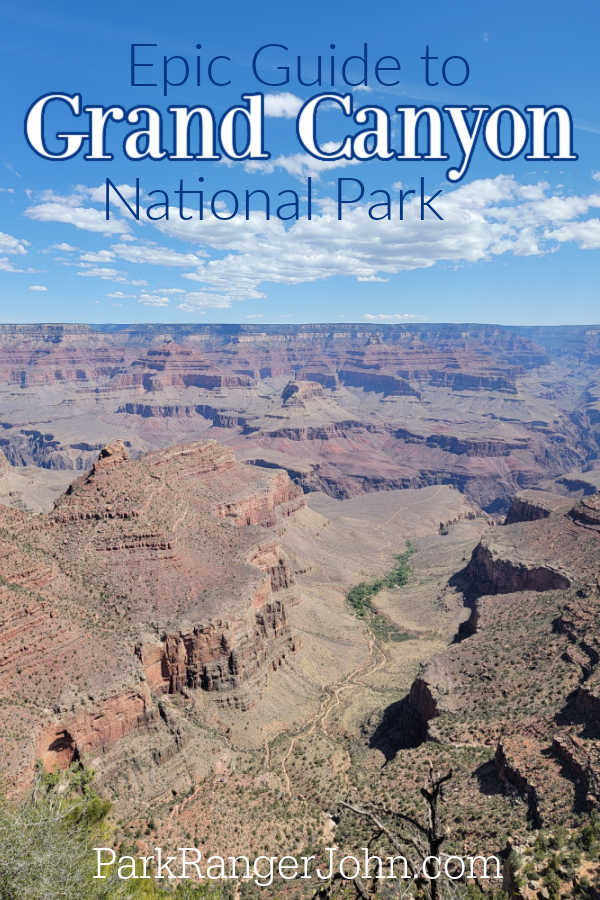
Grand Canyon National Park
Are you in search of a natural marvel with a view that'll take your breath away? If yes, head to the famous Grand Canyon National Park, one of the most visited National Parks in the entire country!
Located in the heart of Arizona, this national park is home to the Grand Canyon, a collection of gorgeous unique red rock structures that have existed for centuries.
With its rich archeological history and one-of-a-kind geological structures, the Grand Canyon National Park has fetched a spot on many people's bucket lists across the world.
The park is known for its scenic views, river streams, unusual weather and topography, variety of hikes, and so much more.
Spread across an area of over a million acres, the canyons go on for as far as the eye can see, so you're to catch views of the sunset and sunrise like you never have before.
The Grand Canyon National Park is home to wildlife like Bighorn Sheep, Bison, Elk, Mule Deer, Mountain Lions, and more.
It also has up to 450 species of birds and was declared as a Globally Important Bird Area. You'll get a chance to explore the park either through its variety of walking or biking trails, catch glimpses of the sunset while you're on a mule trail in South Rim, or even go white water rafting in the beautiful Colorado River for an experience like no other!
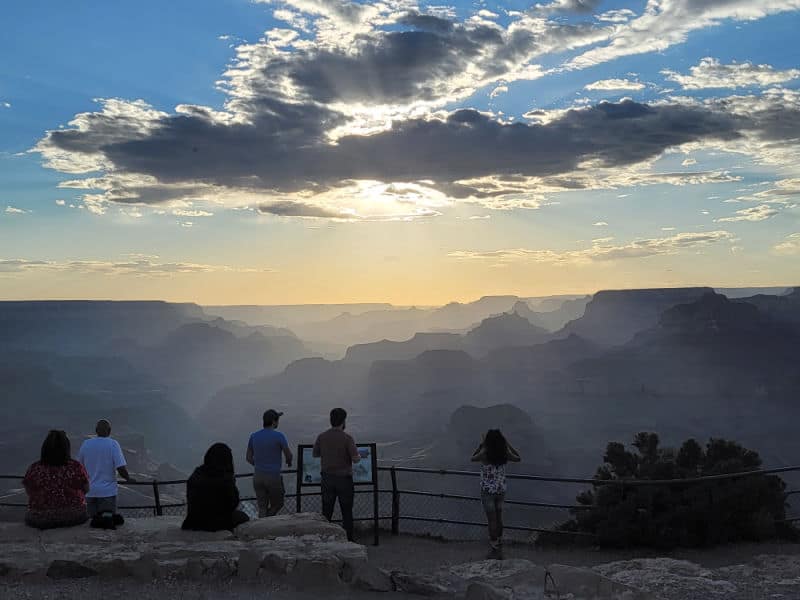
About Grand Canyon National Park
As one of the most visited national parks in the country, the Grand Canyon National Park is a place you must plan a visit to at least once in your lifetime.
With an array of activities, scenic hikes, and more, all surrounded by colorful exposed rock that has evolved in the past couple of centuries, this National Park has its own charm.
With over a million acres, Grand Canyon National park has different experiences to offer in all directions. It is split into the North Rim, South Rim, West End, and East End, each with varied activities, views, and facilities.
The beauty of the beautiful rugged canyons is offset by the gorgeous Colorado River that flows through the canyons (where you can go whitewater water rafting, motorboating, or paddleboarding), making the area an ecosystem within itself.
The unique landscape has such a rich history, with the rocks changing and revealing newer colors as the decades go by, a civilization that grew up in ruins, and wildlife that has adapted to the ways of the Canyon.
The oldest rock layer is believed to have existed for the past 1.7 billion years, while the youngest is 270 million years old!
You'll get a chance to spot the Bighorn Sheep, Elk, Mules (you can even take a hike with them), California Condors (the largest bird in all of North America), the indigenous Grand Canyon Rattlesnake (it's pink in color and isn't found anywhere else in the world besides the nooks and crannies of the Canyon), and even mountain lions if you get lucky!
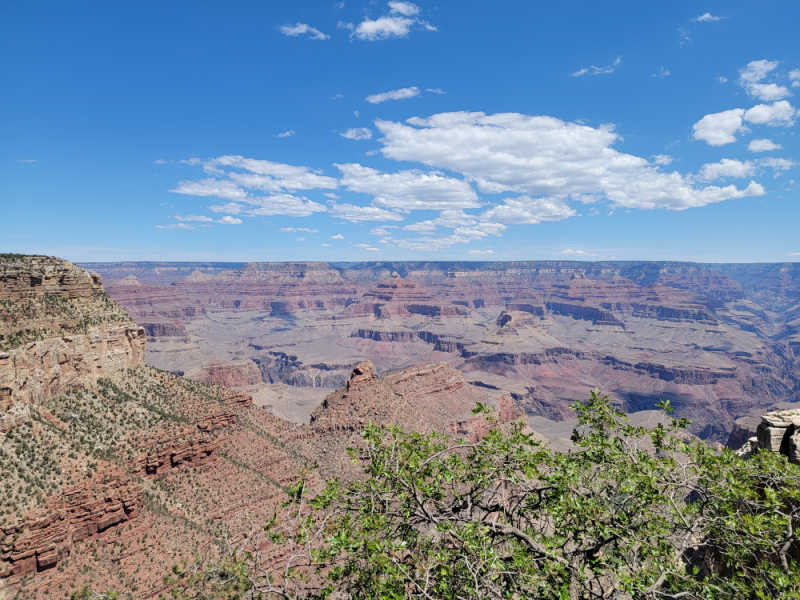
Is Grand Canyon worth visiting?
Not only is it worth seeing, I think it's worth visiting more than once!
I say this because the first time it just blows your mind! Your mind has a hard time wrapping itself around what it's seeing.
Not only that but there's a lot to see in the Grand Canyon. It really is one of those parks where the more you look, the more you discover.
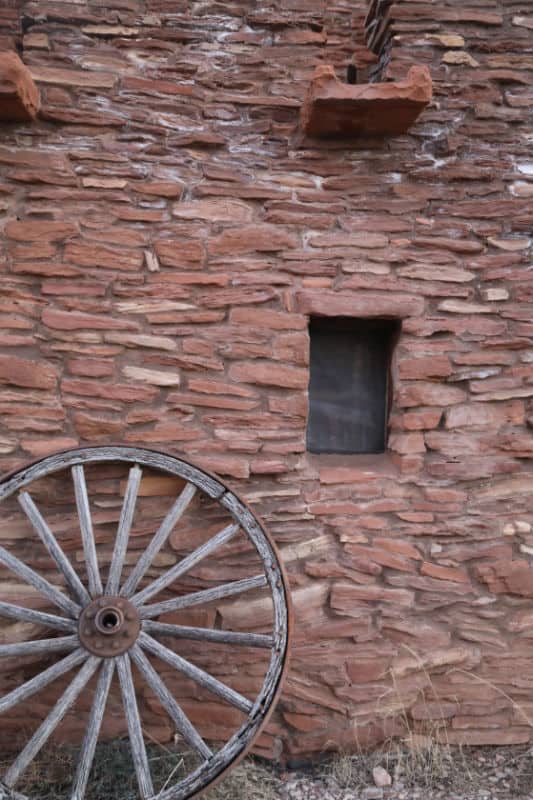
History of the Grand Canyon
The Grand Canyon has lived through centuries of ecological changes, evolution, and climate change, and the beautiful thing about this is that the rocks have motifs of past change.
The complex history of the Grand Canyon National park makes it all the more interesting to learn about and feels more special once you finally happen to visit.
It is believed that while some of the geological formations have existed over nearly a billion years, people began to live in and around the Grand Canyon area up to 12,000 years ago.
In fact, to this day, 11 native tribes continue to call the place home despite the reservations in the 1800s.
The glory of the Canyon dates back to the Treaty of Guadalupe Hidalgo when critical areas of Nevada, California, and more became a part of the United States Territory instead of Mexico.
Within these crucial states was Arizona, home to the Grand Canyon, which was now a part of the United States territory.
Following the agreement, a research team led by Lieutenant Joseph C. Ives was sent to the Canyon and the Colorado River to examine the value of the geological landscape.
While the team came back with the conclusion that the area was a "profit-less" locale and even companies in the 1800s failed to see how they could make the site profitable, the growth of the visitation and tourism of the Grand Canyon has proved these assumptions false.
In 1893, President Benjamin Harrison decided to declare the area a National Forest Reserve as even though it wasn't profitable at the time, it still was a natural wonder like no other.
In 1901, a rail line was constructed to take visitors to the Grand Canon village, and the railway is functional even today!
You can board it in Williams, Arizona, and it travels 65 miles up to the South Rim of the Grand Canyon National Park.
Like the railway, the El Tovar Lodge was also built to accommodate the increasing number of tourists interested in the Grand Canyon.
The El Tovar Lodge is considered one of the most rustic and charming National Park Lodges and became a blueprint for several lodges in other national parks.
In 1903, President Theodore Roosevelt visited the Grand Canyon, stayed at the famous El Tovar Lodge, and gave a speech about the severe need to preserve the area.
In 1908, it was declared to be a National Monument. A few years after the commission of the National Park Service, in 1919, it was re-designated as the Grand Canyon National Park, the 17th National Park of the country.
It's essential to recognize that the people that lived within and around the Canyon have played an integral role in its development, and many devoted their lives to its preservation.
The power of nature shines through with the ability of the Grand Canyon to withstand natural calamities and rapid ecological change that it has witnessed in the past centuries.
While you stand on the edge of the South Rim and watch the sun go down on this one-of-a-kind natural marvel, spend a minute admiring the forces of nature in all their glory.
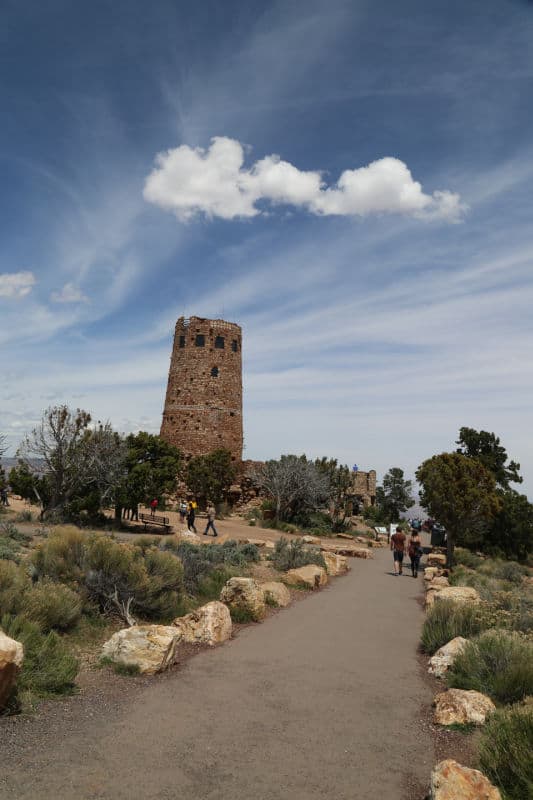
Things to know before your visit to Grand Canyon National Park
To help navigate the park make sure to read more about the Grand Canyon Shuttle Bus. Many areas of the park are only accessible on the bus.
Grand Canyon National Park Entrance Fee
Park entrance fees are separate from camping and lodging fees.
Park Entrance Pass - $35.00 Per private vehicle (valid for 1-7 days from the date of purchase)
Park Entrance Pass - Motorcycle - $30.00 Per motorcycle (valid for 1-7 days from the date of purchase)
Per-Person Entrance Pass - $20.00 Visitors 16 years or older who enter on foot, bicycle, or as part of an organized group not involved in a commercial tour.
$8.00 per person for Non-Commercial Group (16+ persons)
$8.00 per person for vehicles with a capacity of 1-25
$300.00 for Commercial Motor Coach with 26+ seats
Learn more about National Park Passes for parks that have an entrance fee.
$80.00 - For the America the Beautiful/National Park Pass. The pass covers entrance fees to all US National Park Sites and over 2,000 Federal Recreation Fee Sites for an entire year and covers everyone in the car for per-vehicle sites and up to 4 adults for per-person sites.

Buy your pass at this link, and REI will donate 10% of pass proceeds to the National Forest Foundation, National Park Foundation, and the U.S. Endowment for Forestry & Communities.
National Park Free Entrance Days -Mark your calendars with the five free entrance days the National Park Service offers annually.
Time Zone
MST - Mountain Standard Time
Also, remember Arizona does not participate in daylight savings time, so calculate your travel time accordingly.
Pets
Pets are permitted in selected areas in the Grand Canyon National Park. However, they must be on a leash (that's 6ft long or less) at all times.
Pets are allowed on the trails above the rim, Mather Campground, Desert View Campground, Trailer Village Campground, and in developed areas but aren't allowed below the canyon rim, on park shuttle buses, or in-park lodging.
In addition, the Yavapai Lodge has pet-friendly rooms. The Grand Canyon Kennel is located on the South Rim near Maswik Lodge, where boarding is available (only for cats and dogs with vaccination proof).
Cell Service
Cell service is available in some parts of the park. It's become increasingly available on the South Rim and nearing areas (for most phone carriers).
It's a bit spotty on the North Rim and won't be available on any hikes that you go on under the rim, so plan accordingly.
Park Hours
The park's operating hours vary according to seasons and are different for the North Rim and South Rim.
South Rim
It is open 24 hours/day for all 365 days a year, with most attractions open year-round; some may be closed in the winter months.
North Rim
It is open between May 15 and October 15 and closed for the rest of the year. The dates and hours may vary according to each year's plan, so check this web page for official notifications (the website updates daily).
Wi-Fi
Public Wi-Fi is available in specific areas of the Grand Canyon National Park.
Free Wi-Fi is available at the Canyon Village Market Deli and Yavapai Lodge on the South Rim and the General Store (Camper Store) next to the North Rim Campground on the North Rim.
The Wi-Fi works in these areas, but it is slow.
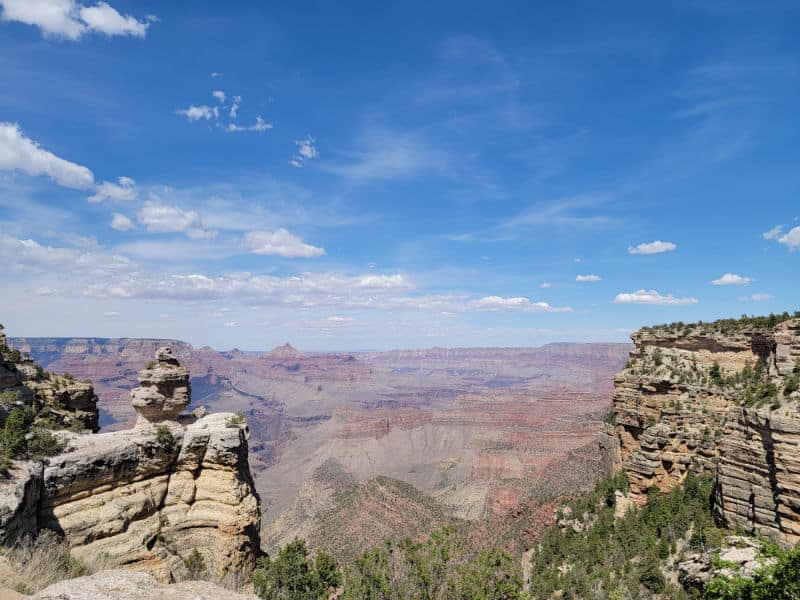
Parking
Parking is available in many areas at Grand Canyon National Park. In South Rim, you'll be able to find parking spaces at:
- South Rim Visitor Center Plaza where has four lots (1,2,3,4).
- Lot 1 - Located closest to Mather Point and has Grand Canyon views. It has spaces for RVs and vehicles with attached trailers.
- Lot 2 - Located closer to the visitor center. It doesn't have spaces for RVs.
- Lot 3 - Considered to be an overflow lot and used in peak season. It is located a short walk away from the visitor center and doesn't have spaces for RVs.
- Lot 4 - Located close to the bicycle rental and café. It doesn't have spaces for RVs.
In the peak tourist season, the visitor center plaza lots probably fill up quite early in the day. In that case, additional parking is available in lots A-B at Market Plaza and C-D in the Village Historic District.
In the North Rim, there is limited parking space. You'll be able to find parking at the North Rim campground or the Grand Canyon Lodge.
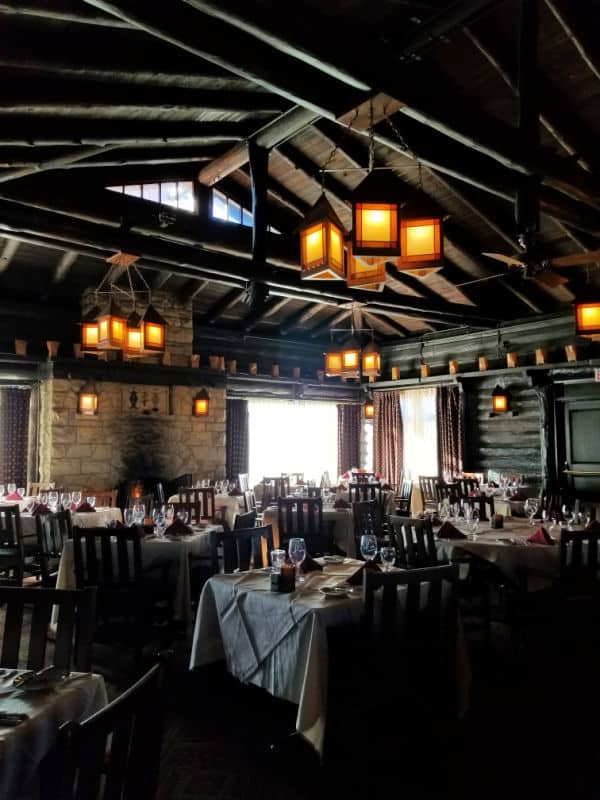
Food/Restaurants
There are several restaurants (and grocery stores) within the National Park and outside the park.
- El Tovar Dining Room
If you're in search of a quintessential national park lodge meal, heading to El Tovar Dining Room is an excellent idea. The interiors of the restaurants with unique wall décor and huge windows truly let the beauty of nature transcend from the canyons into the diner.
- Arizona Room
Overlooking the Canyon and the South Rim trail is the Arizona Room, the in-house diner of the Bright Angel Lodge. Reservations are accepted 30 days in advance, and here you'll be able to enjoy a meal made with fresh produce and accompanied by signature wine.
- Phantom Ranch Canteen
If you're in search of an excellent family breakfast, Phantom Ranch Canteen is the perfect place for you. It is a sought-out place, so it's recommended that you make your reservations well in advance. The canteen sells sack lunches (for $20.85) and serves snacks, beer, wine, and lemonade for everyone to enjoy, especially on a hot summer day.
- Canyon Village Market
This expansive supermarket will have everything you could need and more, from medication to fresh ingredients if you have a cookout, liquor, and more.
- Bright Angel Bicycles & Café
A cafe that is also a bike rental shop, Bright Angel Bicycles & Cafe is located at Mather Point and is a great place to pick up drinks or snacks (like their famous sandwiches) before you begin your tour or hike.
- Food Trucks
Something funky that you can try out is two food trucks located along the South Rim. Open from 11 am to 3 pm in most months and until 5 pm June through August because the days are longer, you can get a hot dog from the Desert Dog food truck and pick up a one-of-a-kind trail mix from the Fuel Your Hike Cart food truck.
- Bright Angel Fountain
Located in the Bright Angel Lodge, this is a great fast food joint in the national park. You'll be able to get pastries, coffee, ice cream, hot dogs, and other snacks for a brief bite before you get on a hike!
- Maswik Food Court
Located in the Maswik Lodge, this cafeteria has warm and filling food, perfect after a long day of exploring the sights of the Grand Canyon National Park. You'll also be able to grab a quick drink and sandwiches on the go.
- Harvey House Café
Located at the Bright Angel Lodge is Harvey House, a standard American diner with pasta, salads, and burgers. A lot of its décor and notecards that you can purchase at its gift store are relics of its rich past.
- Maswik Pizza Pub
Located in the Maswik Lodge near the South village Loop, here you'll be able to pick up a quick slice or sit and enjoy a pie with your family accompanied by an iconic Grand Canyon Pilsner.
- Desert View Market
If you're searching for an ATM and a place to get groceries, wine, and other essential supplies, you can head to the Desert View Market.
- Hermits Rest Snack Bar
Located inside the aesthetic Hermits rest, this is like a vending machine of your dreams. You'll be able to find delicious snacks to keep you energized.
- Yavapai Coffee Shop
Located in the Yavapai Lodge, it is a quaint coffee shop with snacks you can have on the go.
- Yavapai Lodge Restaurant
Located in the Yavapai Lodge, this eatery offers a splendid breakfast buffet (at $15/head) and has a nice spread of pizza, sandwiches, BBQ, and drinks.
- Desert View Trading Post & Deli
Located on Desert View Drive, this Deli is a great place to grab a salad, sandwich, or other snacks if you're in the area.
North Rim Restaurants
On the North Rim, you'll be able to visit these, but keep in mind they're all closed during the winter:
- Grand Canyon Lodge Dining Room
The Grand Canyon Lodge Dining Room serves well-prepared dishes with locally sourced ingredients. The restaurant is set in a beautiful rustic lodge, and you're sure to have a great time here.
- Roughrider Saloon
Perfect for a cold drink and snacks after a long hike. You can also host a bonfire on-site, surrounded by the beauty of the Canyon, and sip on wine as you soak up your day amidst this natural marvel.
- Deli in the Pines
Here you'll be able to get sandwiches, pizza slices (or the whole pie), soup, and more. You can also get snacks on the go. It is open in-season daily from 6 am to 7 pm.
- General Store
If you need some essential snacks, groceries, or other convenience items, you can head to the General Store on North Rim.
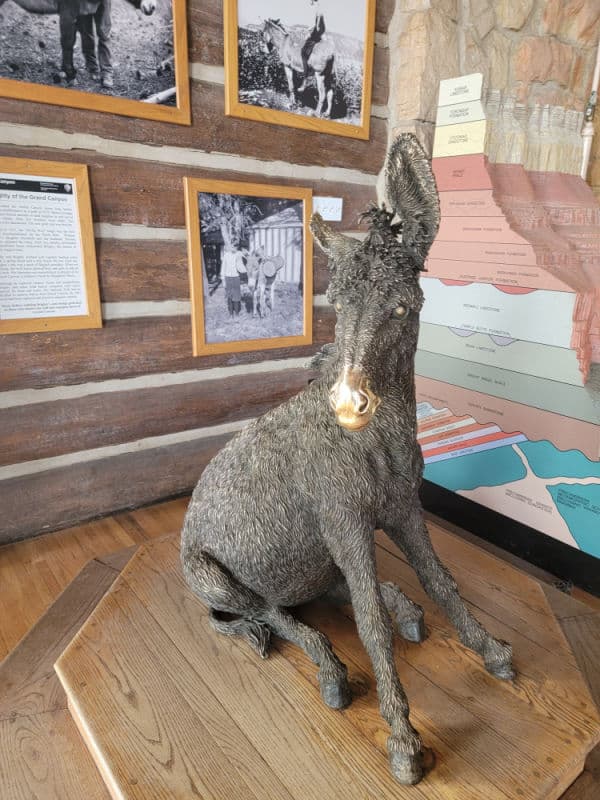
Gas
There is a gas station at Desert View east of Grand Canyon Village where they offer 24-hour pay at the pump gas. Outside the park, the closest gas station is in Tusayan, 7 miles from the south of the Grand Canyon Village (South Rim).
Drones
Drones are not permitted within the National Park.
National Park Passport Stamps
National Park Passport stamps can be found in the visitor center. Make sure to bring your National Park Passport Book with you.
We like to use these circle stickers for park stamps so we don't have to bring our passport book with us on every trip.
The National Park Passport Book program is a great way to document all of the parks you have visitied.
You can get Passport Stickers and Annual Stamp Sets to help enhance your Passport Book.
Grand Canyon is part of the 2019 Passport Stamp Set along with the 1988 Passport Stamp Set.
Grand Canyon Passport Stamp Locations
- Tuweep, AZ
- North Rim
- Grand Canyon
- Phantom Ranch
- Tusayan Ruin
- Kolb Studio
- Indian Garden
- Verkamp’s
- Yavapai Geology Museum
- Visitor Center Plaza
- Desert View Watchtower
Electric Vehicle Charging
There are six EV charging stations are available for visitors to use at Maswik North, Canyon Village Market, and Yavapai Lodge.
Accessibility
All park shuttle buses are accessible. They are equipped with ramps and space for wheelchairs that are not larger than 30 inches wide by 48 inches long (76 by 122 cm).
Most motorized scooters do not fit on the shuttle buses.
You can get a Scenic Drive Accessibility Permit that allows entry to some areas closed to public traffic. These permits are available at the entrance gates and visitor centers.
The park has an accessibility guide that is available at the Grand Canyon Visitor Center, Yavapai Museum of Geology, Kolb Studio, Verkamps Visitor Center, Tusayan Museum, Desert View Visitor Center, or the North Rim Visitor Center.
You can also download the Accessibility Guide, updated 2018, (5.8 MB PDF file)
Don't forget to pack
Insect repellent is always a great idea outdoors, especially around any body of water.
We use Permethrin Spray on our clothes before our park trips. Please read my article on preventing biting insects while enjoying the outdoors.
Sunscreen - I buy environmentally friendly sunscreen whenever possible because you inevitably pull it out at the beach.
Bring your water bottle and plenty of water with you. Plastic water bottles are not sold in the park.
Sunglasses - I always bring sunglasses with me. I personally love Goodr sunglasses because they are lightweight, durable, and have awesome National Park Designs from several National Parks like Joshua Tree, Yellowstone, Hawaii Volcanoes, Acadia, Denali, and more!
Click here to get your National Parks Edition of Goodr Sunglasses!
Binoculars/Spotting Scope - These will help spot birds and wildlife and make them easier to identify. We tend to see waterfowl in the distance, and they are always just a bit too far to identify them without binoculars.
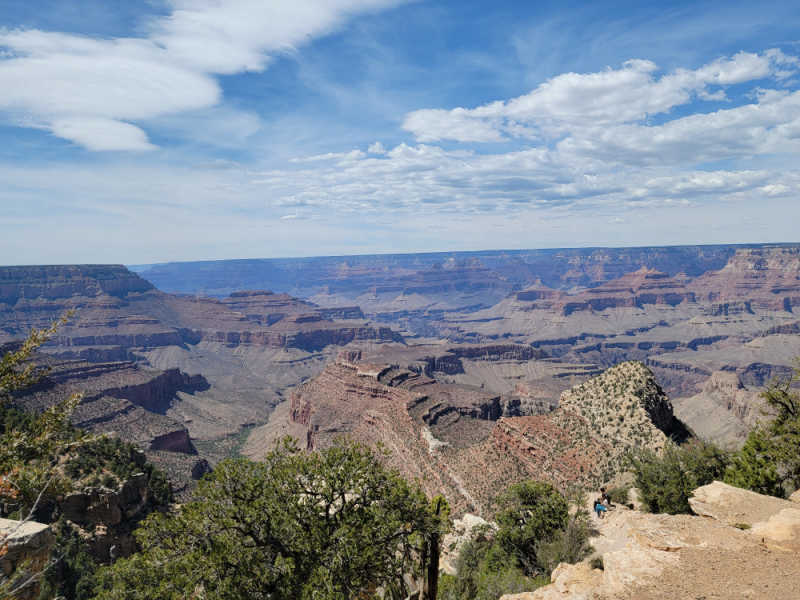
Details about Grand Canyon National Park
Size - 1,218,375 acres
Grand Canyon NP is currently ranked at 11 out of 63 National Parks by Size.
Grand Canyon National Park encompasses 1,904 square miles.
Date Established
While the Grand Canyon's natural elements date back to over a billion years ago, it became a part of the United States territory after signing the Treaty of Guadalupe Hidalgo in 1848.
Following this, the area was assigned as a National Forest Reserve in 1893 by President Benjamin Harrison.
Then, in 1908 it was designated a National Monument by President Theodore Roosevelt, and a few years after the establishment of the National Park Service, on 26 February 1919, it was declared as the Grand Canyon National Park by President Woodrow Wilson.
The park was designated a UNESCO World Heritage Site on October 26, 1979.
The park was designated an International Dark Sky Park in 2019.
Visitation
In 2021, Grand Canyon NP had 4,532,677 park visitors.
In 2020, Grand Canyon NP had 2,897,098 park visitors.
In 2019, Grand Canyon NP had 5,974,411 park visitors.
Learn more about the most visited and least visited National Parks in the US
National Park Address
20 South Entrance Road
Grand Canyon, AZ 86023
Grand Canyon National Park Map
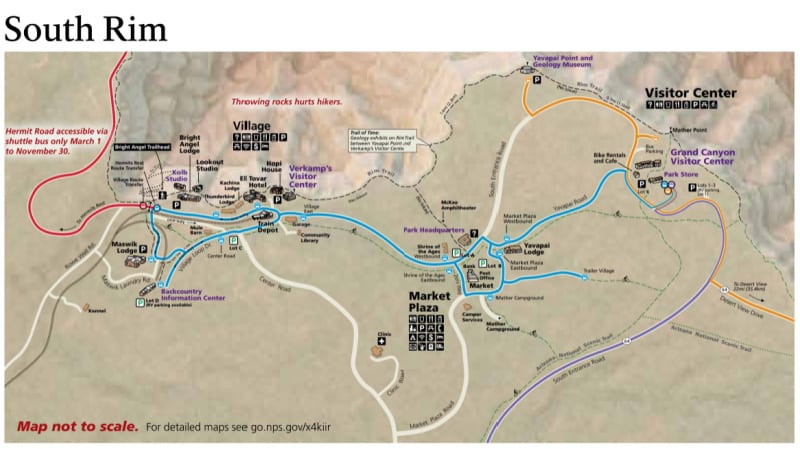
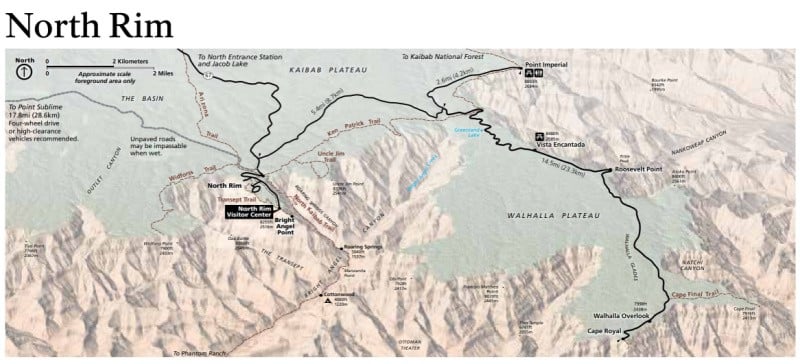
For a more detailed map we like the National Geographic Trails Illustrated Maps available on Amazon.
There is also a Grand Canyon Trail Map available.
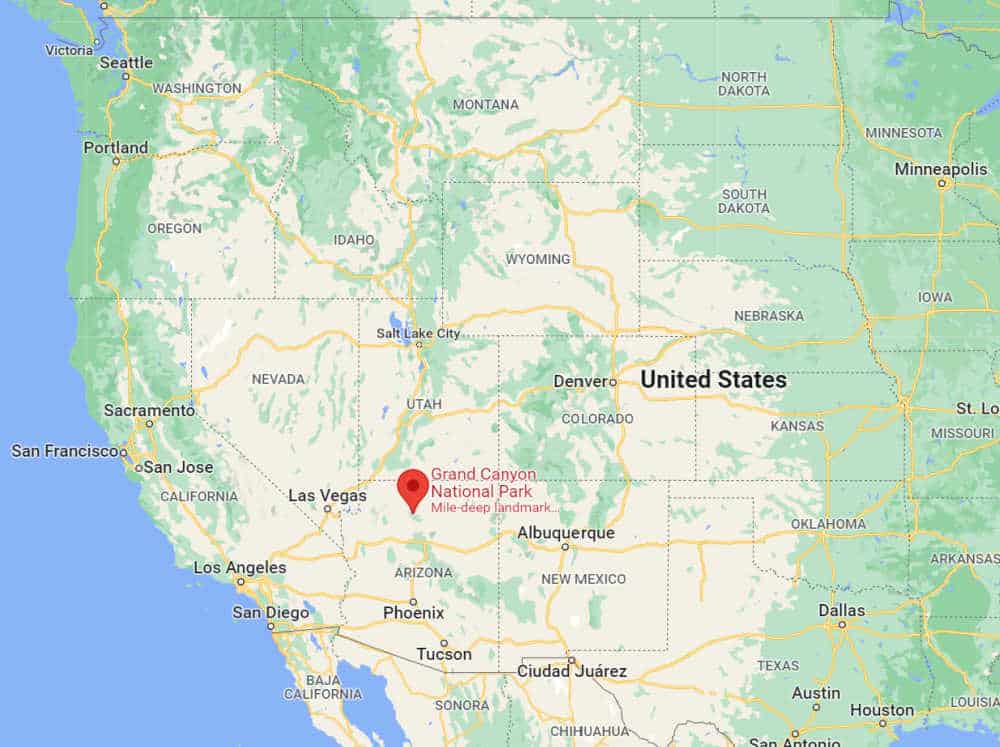
Where is Grand Canyon National Park?
The Grand Canyon National Park is located in the heart of Arizona, with the North Rim accessible from Las Vegas and the South Rim closer to Phoenix.
The park encompasses about 1.2 million acres of space with unique red rock geological formations, various viewpoints that overlook the landscape, the glistening and scenic Colorado River, the Havasu Waterfalls, the rich history of indigenous tribes, and more.
Estimated distance from major cities nearby
- Tusayan, AZ - 7 miles
- Flagstaff, AZ - 79 miles
- Sedona, AZ - 114 miles
- Page, AZ - 132 miles
- Phoenix, AZ - 229 miles
- Las Vegas, NV - 280 miles
- Albuquerque, New Mexico - 410 miles
- Los Angeles, CA - 490 miles
Estimated Distance from nearby National Park
Miles are estimated from the Grand Canyon Village, South Rim
Saguaro National Park - 336 miles
Zion National Park - 252 miles
Petrified Forest National Park - 196 miles
Mesa Verde National Park - 280 miles
Bryce Canyon National Park - 287 miles
Arches National Park - 341 miles
Canyonlands National Park - 360 miles
Where is the National Park Visitor Center?
There are three major visitor centers located by the South Rim and one near the North Rim to offer information about the park and its facilities and host exhibits that reflect its culture and history.
On the South Rim:
The South Rim Visitor Center
Open 9 am - 4 pm daily, all year-round - The building is currently closed until further notice
Located in the Canyon View Information Plaza at Mather Point, this visitor center can be visited by a free shuttle ride. It is home to displays that give you ideas of things to do in the park and has people on board to assist you with anything you need.
The Verkamp Visitor Center
Open 8 am - 6 pm daily, all-ear round
Located near the infamous El Tovar Hotel, it is the national park's newest visitor center. At this old family home, you can shop for souvenirs and visit the nearby Yavapai Geology Museum.
The Yavapai Geology Museum
Open 8 am - 6 pm daily, all-year-round
Located east of the Market Plaza, here you'll be able to find all the information you need about the area's rich geological and natural history. It has unobstructed views of the canyons and a shop for all your souvenirs.
The Kolb Studio
Open 8 am - 6 pm daily, all-year-round
Located in the Village Historic District at Bright Angel trailhead, it is is an art and photography studio with free admission.
Here you'll be able to observe many art exhibits interact with well-known photographs, films, and other art inspired by the Grand Canyon. From this visitor center, you'll also be able to begin the Bright Angel trail.
Desert View
Desert View Information Center and Bookstore
Located beside the park's East Entrance, this information center has information about the region and a mall shop for mementos.
The Tusayan Museum
closed until further notice due to the current health crisis
Located close to the East Entrance in the Desert View area, this museum has exhibits with the Grand Canyon's artifacts and rich culture with free admission.
On the North Rim
North Rim Visitor Center
Open May through October, hours vary
Located within close proximity of the Grand Canyon Lodge, this lodge offers information on the canyons, their history, people, and more.
The sunrise at the North Rim Lodge patio (which is a short walk from this visitor center) are breathtaking!
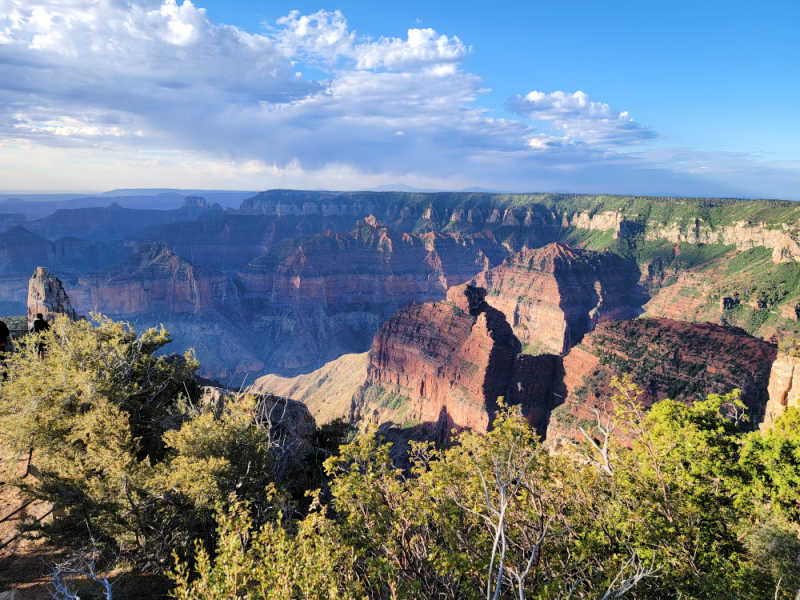
Getting to Grand Canyon National Park
Closest Airports
International Airports
Phoenix Sky Harbor International Airport (PHX) - 231 miles (from South Rim)
Las Vegas McCarran International Airport, Nevada (LAS) - 121 miles (from West Rim, parts of this area aren't included as parts of the Grand Canyon National Park) or 281 miles (from South Rim)
Regional Airports
Grand Canyon National Park Airport (GCN) - 7 miles from South Rim
Flagstaff Pulliam Airport (FLG) - 81 miles from the South Rim
Driving Directions
Depending on which part of the park (North Rim or South Rim) you'd like to explore, the way to get there by road is as follows -
To get to South Rim:
From Flagstaff, Arizona (81 miles away)
You'll take Interstate 40 West to Williams and then merge with Highway 64 North to reach South Rim.
From Phoenix, Arizona (231 miles away)
You'll take Interstate 17 North to reach Flagstaff from where you'll take Interstate 40 West to Williams and then merge with Highway 64 North to reach South Rim.
From Las Vegas, Nevada (278 miles away)
You'll take Highway 93 South towards Kingman, Arizona. Once you reach Kingman, you'll get on Interstate 40 East to Williams and merge with Highway 64 North to reach South Rim.
From Los Angeles, California (494 miles away)
You'll begin your journey by getting on Interstate 15 East towards Barstow, California, from where you'll get on Interstate 40 East towards Williams and then merge with Highway 64 North to reach South Rim.
From Denver, Colorado (859 miles away)
You'll begin your trip by taking Interstate 25 South towards Albuquerque, from where you'll get on Interstate 40 West to Williams and merge with Highway 64 North to reach South Rim.
To get to North Rim:
From Flagstaff, Arizona (207 miles away)
You'll take Highway 89 North towards Bitter Springs, from where you'll take Highway 89 West to Jacob Lake. Then, you'll merge with Highway 67 South to reach North Rim.
From Phoenix, Arizona (351 miles away)
You'll take Interstate 17 North towards Flagstaff, then follow Highway 89 North towards Bitter Springs, from where you'll take Highway 89 West to Jacob Lake.
Then, you'll merge with Highway 67 South to reach North Rim.
From Las Vegas, Nevada (275 miles away)
You'll begin by driving North on Interstate 15 until you reach Route 9. You'll continue to Route 59 (the route will change to 389 after crossing the Utah border into Arizona).
You'll continue going East on Route 389 (previously 59) until you reach the junction with US Route 89a and then Route 67.
Driving on Route 67 for nearly 50 miles will lead you to reach North Rim.
You can drive in from California, New Mexico, and Colorado, but the routes are long, so it's better to chart out your extensive itinerary on google maps well in advance if you're hoping to reach North Rim from these areas.
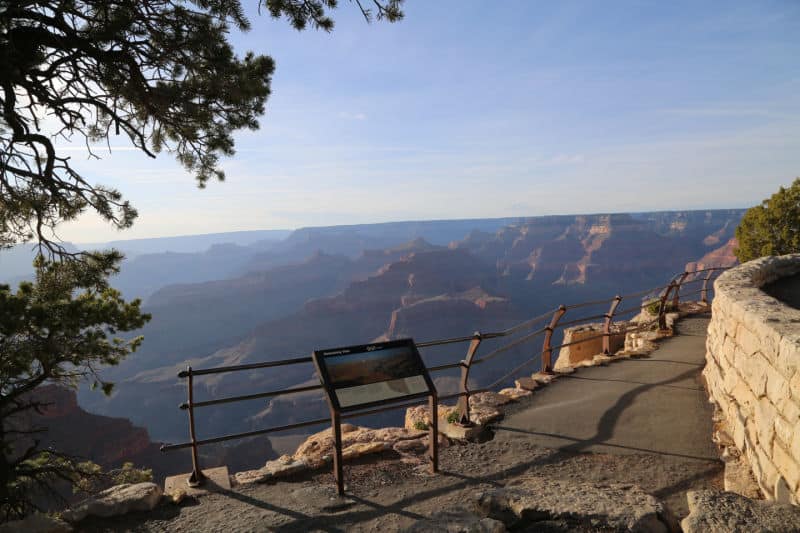
Best time to visit Grand Canyon National Park.
Let's face it, the Grand Canyon is busy! If you want to beat the crowds, I would suggest early mornings and late afternoons.
It also slows down in the winter but there is limited access and there are still people wanting to see the canyon.
The best things you can do is avoid holidays, weekends, and the busy summertime.
National Park Weather and Seasons
Spring
During the Spring, visiting the Grand Canyon National Park is a great idea as the crowds are more sparse, the North Rim is slowly opening back up, and the weather isn't too hot to handle.
You'll be able to visit all the attractions without too much rush, camp in the pleasant weather, and even catch some stellar sunsets over the Canyon.
Summer
The summer is loved by many tourists but has more downsides than upsides to it.
With peak tourists season since school is out and extremely high temperatures and humidity, it can be exhausting to be in queues and surrounded by people constantly.
Autumn/Fall
Visiting in the fall is a great idea, especially if you're looking to tour South Rim) as the peak summer crowds die down and the weather also becomes more pleasant.
However, many attractions, particularly on the North Rim, close down during the onset of winter, and the weather, even in September, can get pretty chilly since the canyons comprise such a unique natural landscape.
Winter
If you're for a budget-friendly trip, you can visit the South Rim during the winter months but beware that the weather can get extremely chilly.
Some activities may also be closed in the South Rim due to harsh weather conditions in the winter.
However, the area and facilities in the North Rim remain closed throughout the winter except for permitted backcountry camping and cross-country skiing.
Average Temperature by Area
South Rim
Mean High Temperature (30 year average): 64°F (17.8°C)
Mean Low Temperature (30 year average): 29.5°F (-1.4°C)
Average Annual Precipitation (30 year average): 13.4 inches (34.0 cm)
Total Precipitation in 2021: 11.5 inches (29.2 cm)
North Rim
Mean High Temperature (30 year average): 55°F (12.8°C)
Mean Low Temperature (30 year average): 31.7°F (-0.2°C)
Average Annual Precipitation (30 year average): 24 inches (62 cm)
Total Precipitation in 2021: unavailable due to missing data
Phantom Ranch
Mean High Temperature (30 year average): 81°F (27.2°C)
Mean Low Temperature (30 year average): 54.2°F (12.3°C)
Average Annual Precipitation (30 year average): 9.6 inches (24 cm)
Total Precipitation in 2021: unavailable due to missing data
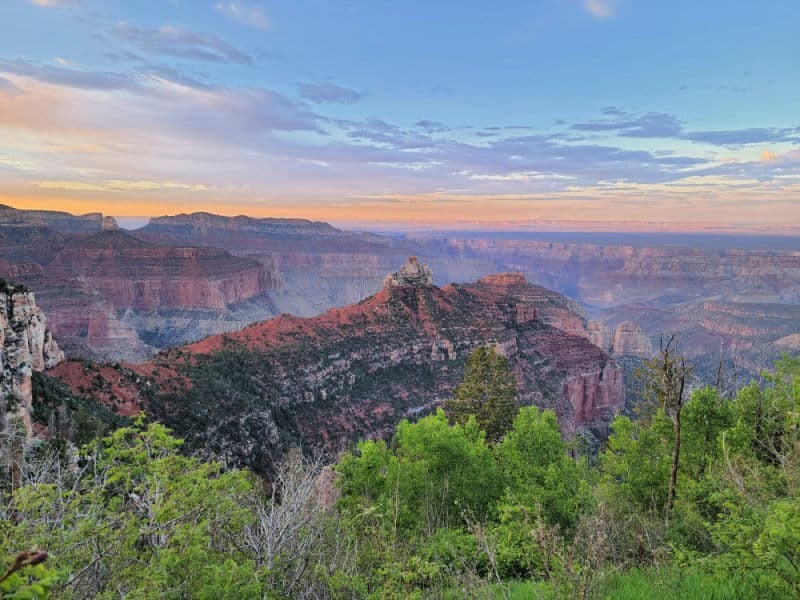
Best Things to do in Grand Canyon National Park
There are so many epic things to see and do in the Grand Canyon. Make sure to check out our full Things to do Grand Canyon NP post to see all of the options.
Some of the top things to do include mule rides to the bottom of the canyon floor, Grand Canyon Railway, hiking trails including the North Kaibab Trail, and spending time staring at the epic colorful rock formations that make up the Grand Canyon.
Wildlife viewing
Well-known wildlife within the park includes Bighorn Sheep, Elk, Mountain Lions, Grand Canyon Rattlesnakes, Javelina, mules, and more that you might be able to spot.
If you want to spot some wildlife, you can read up on their habitats and likely sightings, but ensure that you remember to practice caution in case of a sighting and respect their home.
Junior Ranger Program
You can pick up a Junior Ranger program at any visitor center within the Grand Canyon National Park.
Bird Watching
The Grand Canyon National Park is home to nearly 450 species of birds and was declared a Globally Important Bird Area in 2014.
It also houses some of the rarest and most endangered species like the California Condor, Mexican Spotted Owl, Yuma Clapper Rail, amongst many others.
Guided Tours
Grand Canyon Railway - Hop aboard the Grand Canyon Railway for an unforgettable trip to the Grand Canyon. With either coach or first-class tickets, marvel at the scenic Arizona countryside as you delight in the retro interior and travelling minstrels along the way.
Helicopter Tour - Fly over the Grand Canyon in a helicopter and see the North and South Rim from above. Add a Hummer tour at sunrise or sunset and get a closer look at the Grand Canyon's landscape.
Discovery Flight - Enjoy scenic views of the Zuni Corridor, Imperial Point, Confluence of the Colorado & Little Colorado Rivers, Kaibab National Forest & Kaibab Plateau.
Off Road Sunset Safari - Bypass long lines and venture off-road down historic stagecoach trails through the Kaibab Forest. Visit viewpoints along the Canyon’s edge and enjoy sunset views on this guided skip-the-gate tour.
IMAX Movie - Head below the rim of the Grand Canyon on an IMAX adventure you will never forget. In only 34 minutes, experience 4,000 years of human history and enhance your visit to The Grand Canyon.
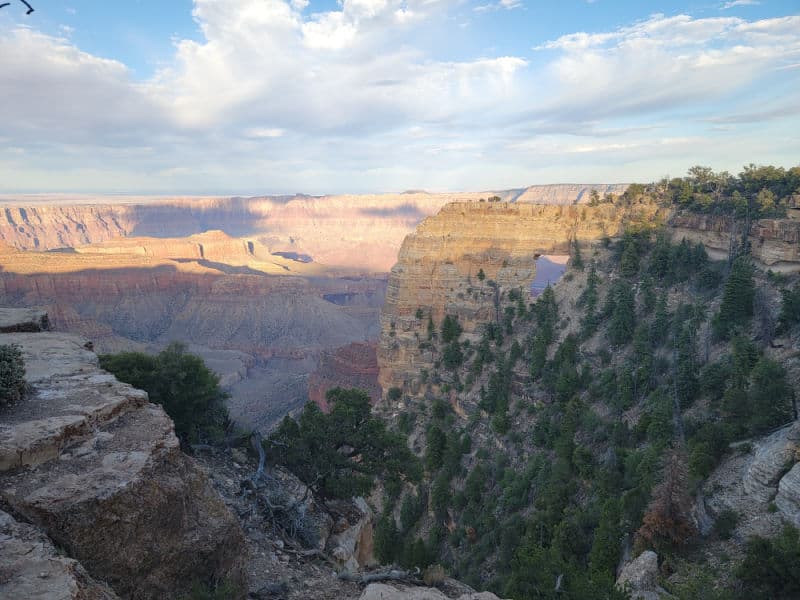
Hiking in Grand Canyon National Park
You'll have several opportunities to go hiking in this national park, so before anything else, remember to always carry the ten essentials for outdoor survival when exploring.
Since it is such a unique landscape, the hikes in this region can test your mental and physical strength, so proceed with caution, but also know that it's a gratifying and worthwhile experience to tour the Canyon's sights while on a hike.
There are so many trails varying in difficulty, Distance, and altitude, so pick wisely and stay hydrated!
Besides these activities, you can also explore the Colorado River via rafting or paddle boarding, visit the visitor centers, learn more about the unique geological history of the canyons, go on a bike trail, and so much more. At this wonder of the world, the opportunities are virtually endless.
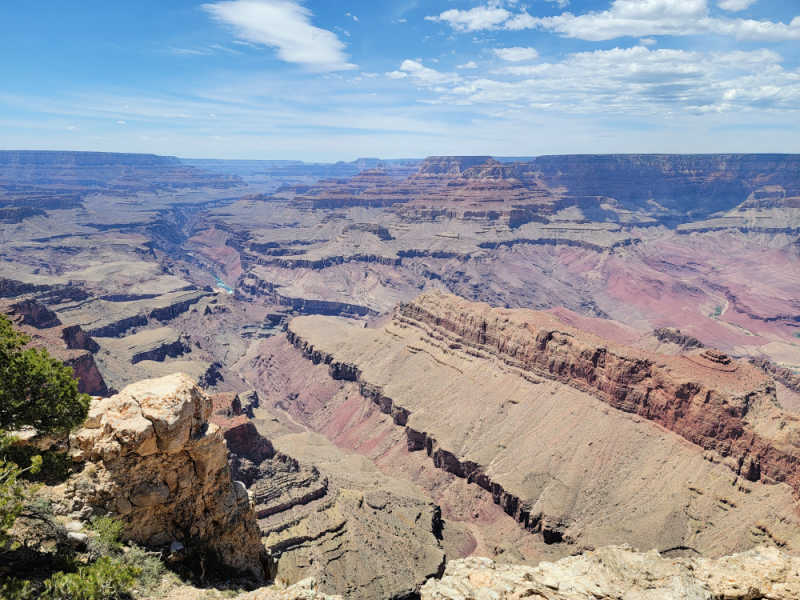
How to beat the crowds in Grand Canyon NP?
The best way to avoid the crowds at Grand Canyon National Park is to visit during the early Summer months (April to June).
During this time, the North Rim is just opening back up, so it is less crowded than the South Rim, which is open for visitors all year round.
To visit the North Rim and get the best of the place, tour in the Spring, just after its opened post-winter closure.
Vising the South Rim is an excellent idea in the fall as the crowds are slightly more sparse than in the early Summer months, and the weather is more pleasant than the blistering heat of the peak summertime.
You'll best be able to avoid the crowds no matter what time of year you visit, as long as you arrive early to the park before the parking spaces fill up and attraction lines become longer and longer.
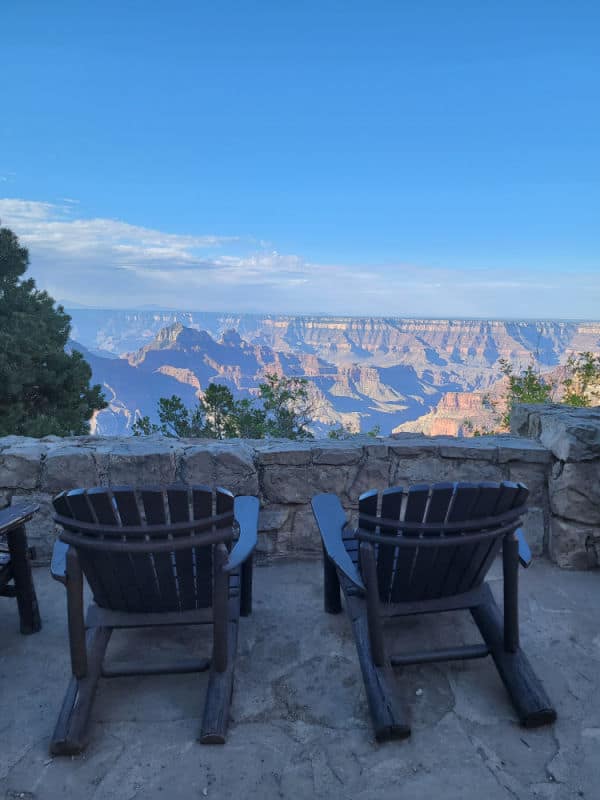
Grand Canyon National Park Lodging
There are multiple National Park Lodges within the Grand Canyon National Park. Choosing which lodge to stay in depends mainly on the parts of the park you're hoping to explore!
El Tovar (South Rim)
This Registered National Historic Landmark was first built in 1905 (when it welcomed President Theodore Roosevelt) and renovated in 2005.
With rooms that have a great view of the landscape, the rustic and charming architecture of the El Tovar became a blueprint for many lodges in National Parks across the US.
It is home to a concierge service, a fine-dining restaurant, a gift shop, and more.
Click here to book your stay at the El Tovar!
Click here to read all about the El Tovar Hotel.
Yavapai Lodge (South Rim)
It is one of the lodges in the Grand Canyon that looks unassuming but will surprise you in the best way possible.
You'll be accommodated with the best service, and if you get lucky (like we did), you might even spot an Elk on the grounds of the lodge itself.
Click here to book your stay at Yavapai Lodge.
Click here to read all about the Yavapai Lodge.
Bright Angel Lodge (South Rim)
One of the top places to stay in the Grand Canyon National Park, the Bright Angel Lodge is home to the Arizona Room (a lovely fine-dining joint with a view) as well as an ice-cream parlor.
It is the closest lodging option close to the famous Bright Angel Trail, and here you can also rent one of the log cabins if you're looking for a fun romantic getaway.
Click here to book your stay at the Bright Angel Lodge.
Click here to read all about the Bright Angel Lodge.
Kachina Lodge & Thunderbird Lodge (South Rim)
If you're in search of accommodation for big groups and families, the Kachina and Thunderbird lodges are the ones for you.
They're located near the edge of the South Rim within proximity of the El Tovar Hotel. With their central location, you'll have easy access to trails restaurants and even have scenic vistas of the Canyon in all its splendor.
Click here to book your stay at the Kachina Lodge.
Click here to book your stay at the Thunderbird Lodge
Click here to read more about the Kachina Lodge.
Maswik Lodge (South Rim)
Located near the canyon edge in the Ponderosa Pine forest is a modern, motel-style cabin called Maswik Lodge.
With its rich history and culture, this lodge has in-house dining, a gift shop, and easy access to trails. Reservations are recommended to be made up to a year in advance.
Click here to book your stay at Maswik Lodge.
Click here to read more about Maswik Lodge.
Phantom Ranch (South Rim)
Located north of the Bright Angel Campground, this lodge is a popular spot amongst overnight hikers, mule riders, river rafting groups, and more!
The Phantom Ranch, considered one of the nation's top National park lodges, is a favorite among tourists, so make your reservations in advance.
Grand Canyon North Rim Lodge (North Rim)
Closed in the winter, the Grand Canyon North Rim Lodge is the only in-park accommodation in the North Rim part of the Grand Canyon.
It's well sought-out so book your rooms at least a year in advance. The cozy and rustic design, coupled with the limestone architecture, genuinely brings the canyons' natural beauty into the lodge itself.
Click here to book your stay at the Grand Canyon North Rim Lodge.
Click here to read more about the Grand Canyon North Rim Lodge.
Lodging near Grand Canyon National Park
For the South Rim, the closest lodging can be found in Tusayan, Arizona.
Grand Canyon Plaza Hotel - Take advantage of a terrace, a garden, and a bar at Grand Canyon Plaza Hotel. For some rest and relaxation, visit the hot tub. Be sure to enjoy a meal at JJKs, the onsite family restaurant. Free in-room Wi-Fi and a 24-hour business center are available to all guests.
Red Feather Lodge - Take advantage of laundry facilities, a bar, and a gym at Red Feather Lodge. Be sure to enjoy a meal at Plaza Bonita, the onsite restaurant. Stay connected with free in-room Wi-Fi.
Holiday Inn Express Hotel & Suites Grand Canyon - Holiday Inn Express Hotel & Suites Grand Canyon, an IHG Hotel provides amenities like free to-go breakfast and a business center. Stay connected with free in-room Wi-Fi.
The Grand Hotel - At The Grand Hotel at the Grand Canyon, you can look forward to shopping on site, a fireplace in the lobby, and a bar. For some rest and relaxation, visit the hot tub. The onsite restaurant, Canyon Star Steakhouse, features American cuisine and happy hour. Stay connected with free in-room Wi-Fi, and guests can find other amenities such as a 24-hour business center.
Best Western Premier Grand Canyon Squire Inn - Consider a stay at Best Western Premier Grand Canyon Squire Inn and take advantage of a coffee shop/café, a garden, and an arcade/game room. For some rest and relaxation, visit the 2 hot tubs. Enjoy a meal at the two onsite restaurants. Free in-room Wi-Fi, with speed of 25+ Mbps, is available to all guests, along with laundry facilities and a fireplace in the lobby.
Click on the map below to see additional hotels and vacation rentals near the Grand Canyon.
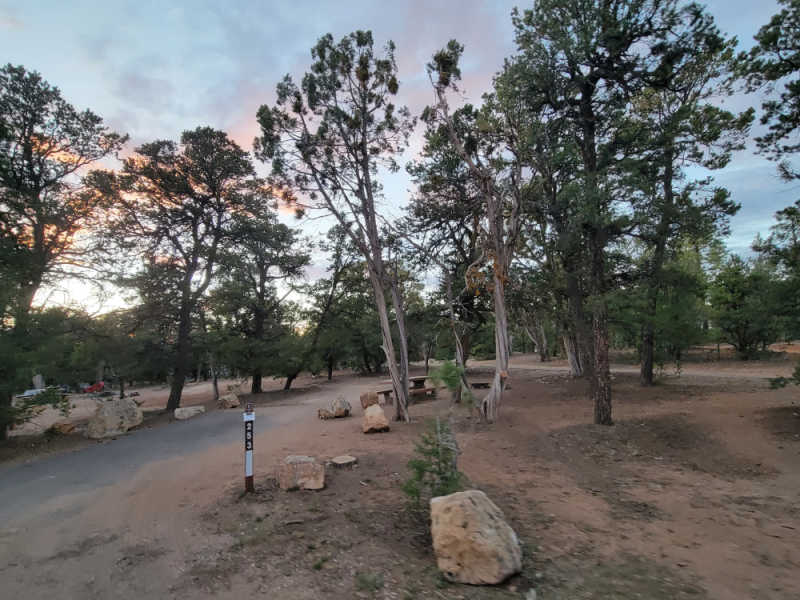
Grand Canyon NP Campgrounds
Season: Year-Round
Campsites: 381 (RVs permitted )
Located on the South Rim, this campground has a picnic table, parking space, campfire ring, flush toilets, and drinking water.
There are no hookups available, but it is a free dump station. Reservations are required throughout most of the year; in the winter months, campgrounds are allotted on a first-come, first-serve basis.
Family site for $18.00/night, and there are different packages you can look at depending on your needs.
Season: April to October
Campsites: 49 (RVs permitted)
Located on the East end of the National Park, this campground is open only seasonally and has potable water, ice available for sale, firewood, and flush toilets all available seasonally.
Reservations are required and cost $18.00/night.
Season: Year-Round
Campsites: 123 (RVs only)
Located on the South Rim, a trailer-only campground with well-paved roads, potable water, flush toilets, and ice is available for sale.
Reservations are required and recommended up to a year in advance, and cost depends on the size of the lot you're booking (e.g., for a 28 foot RV lot, it'll cost you up to $75)
Season: May to October (the dates from when the North Rim is open)
Campsites: 87 (RVs permitted)
Located on the North Rim, you'll have access to some of the oldest trails, unparalleled views of the natural marvel, and even get a chance to spot some of the park's wildlife.
It has potable water, firewood, and ice for sale, a camp store, and an amphitheater, all available seasonally.

For a fun adventure check out Escape Campervans. These campervans have built in beds, kitchen area with refrigerators, and more. You can have them fully set up with kitchen supplies, bedding, and other fun extras. They are painted with epic designs you can't miss!
Escape Campervans has offices in Vancouver, Seattle, Portland, San Francisco, Las Vegas, Los Angeles, Phoenix, Salt Lake City, Denver, New York, and Orlando
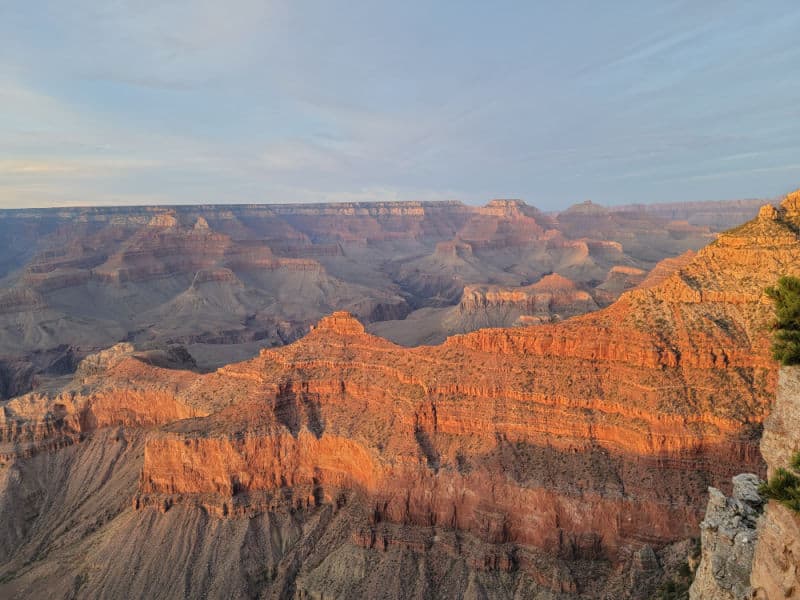
Travel Tips
Many areas of the park are only accessible via shuttle buses. Make sure and plan in time to wait for the buses and if there is a line. Also, bring water with you since it can get quite warm.
Be prepared for bugs! Mosquito repellent is your friend. We have started using this spray that you can put on your clothes before your trip.
Please be careful! Every time we are at the Grand Canyon we have a few gasping moments as people back up towards the edge for photos.
Water, water, and more water! Make sure and bring a water bottle with you. The park no longer sells bottled water. You can buy a water bottle at the gift stores and fill them up in most of the buildings.
90% of park visitors visit the South Rim, be wild and take a trip to the North Rim for a different perspective of the park.
Be aware of the elevation, bring sunscreen and a hat. I managed to get quite pink on our last trip because we forgot sunscreen.
Parking can get a bit crazy depending on where you are in the park. If you are staying at one of the lodges you may need to make a few loops to get a spot near the lodge.
Be prepared for crowds! Have a family meeting spot that everyone knows to go to. It is very easy to get lost in a crowd at the popular overlooks and near the visitor center.
After a few pull-offs, it honestly starts to look the same. Pick and choose which ones you want to visit.
Keep an eye out for wildlife. We saw elk right next to the road as we were driving through the park.
Get gas before you get into the park!
The general store is great for souvenirs, snacks, and drinks. There is even a special Grand Canyon wine that benefits conservation.
Tour buses are the only way to access some sections of the park. Be prepared to wait at times for the buses.
If you are driving into the park check out the East entrance. You can drive up to many overlooks on your own and check out the views
Be prepared for bugs! Mosquito repellent is your friend! I know I said this twice but trust me it is a thing!
The sunset tour is a great way to see the park at dusk and get to the best sunset spots.
Grand Canyon Facts and Statistics
Length: 278 river miles (447 km)
Width:
Minimum at Marble Canyon, 600 feet (180 m)
Average Rim to Rim, 10 miles (16 km)
Maximum Rim to Rim, 18 miles (28.8 km)
Depth: Average, 1 mile (1.6 km)
Elevations:
South Rim 7,000 feet (2,100 m)
North Rim 8,000 feet (2,400 m)
450 species of birds can be found in the park during different times of the year.
92 Mammal species are found in the park.
18 species of fish with 5 of them native species.
58 reptiles and amphibians can be found in the park.
1,443 species of invertebrates are found in the park including 292 butterflies and moths.
30 non native exotic animals can be found in the park.
Federally Endangered and Threatened Species: California condor, humpback chub, razorback sucker, Southwestern Willow Flycatcher, Ridgway's rail, Mexican Spotted Owl, yellow-billed cuckoo, and desert tortoise.
There is 1 reptile, 3 mammals, and one mollusk species that is only found in the Grand Canyon region. There are 9 species of insects endemic to the Grand Canyon along with 6 fish in the Colorado River Basin.
There are 11 federally recognized tribes with deep history and connection to the Grand Canyon including the Havasupai Tribe, Hopi Tribe, Hualapai Tribe, Kaibab Band of Paiute Indians, Moapa Band of Paiute Indians, Navajo Nation, Paiute Indian Tribe of Utah, San Juan Southern Paiute Tribe, The Pueblo of Zuni and the Yavapai Apache Nation.
There are 35 miles of paved trails along with 148 miles of unpaved trails in the park.
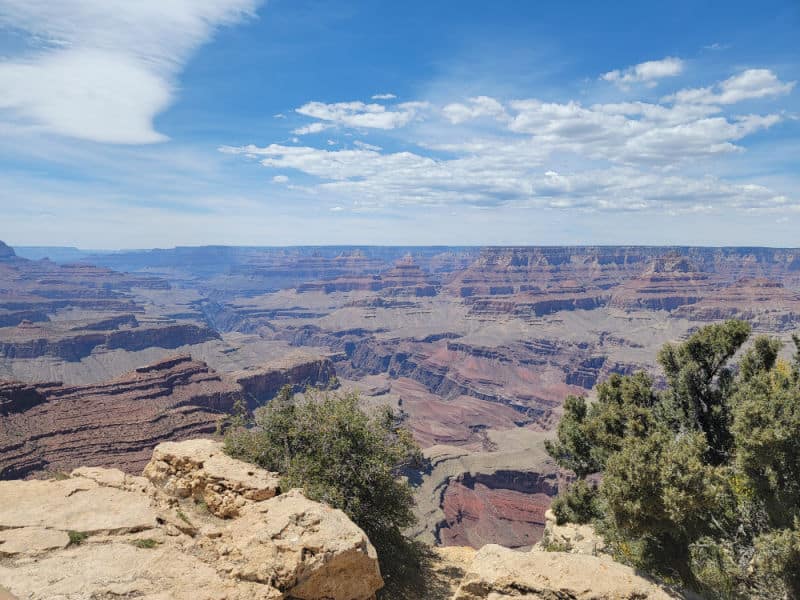
Parks near National Park
Navajo National Monument
Pipe Springs National Monument
Lake Mead National Recreation Area
Hubbel Trading Post National Historic Site
Check out all of the Arizona National Parks along with neighboring National Parks in Utah, National Parks in New Mexico, California National Parks, Colorado National Parks, and Nevada National Parks
Check out this list of US National Parks to count how many you have visited!
Make sure to follow Park Ranger John on Facebook, Instagram, Pinterest, and TikTok
